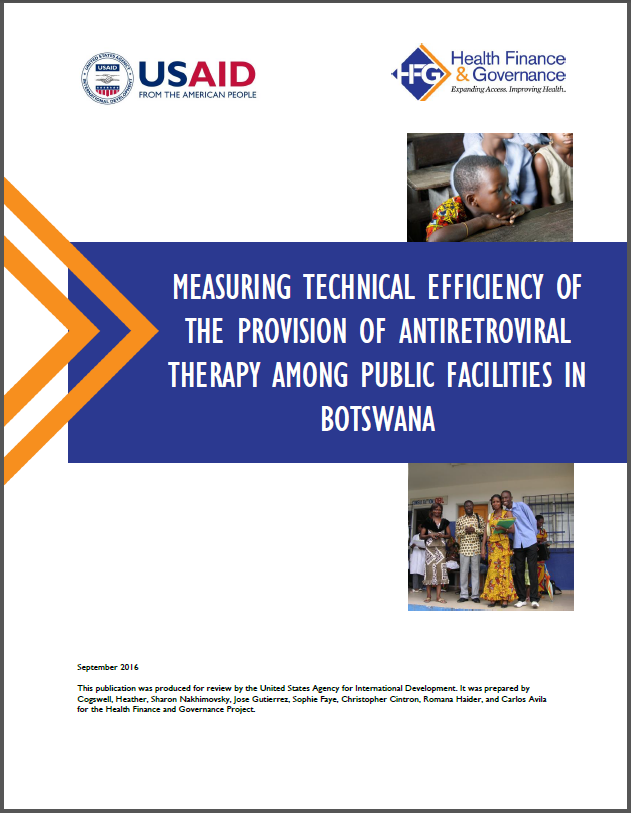Measuring Technical Efficiency of the Provision of Antiretroviral Therapy Among Public Facilities in Botswana
Categories: HIV/AIDS, Home Page Map, Publications, Where We Work
Resource Type: Report
 Authors: Heather Cogswell, Sharon Nakhimovsky, Jose Gutierrez, Sophie Faye, Christopher Cintron, Romana Haider, and Carlos Avila
Authors: Heather Cogswell, Sharon Nakhimovsky, Jose Gutierrez, Sophie Faye, Christopher Cintron, Romana Haider, and Carlos Avila
Published: September 2016
Resource Description: Botswana has made great strides in combating the HIV epidemic. Deaths due to AIDS have declined dramatically since 2005 (UNAIDS 2014; 2016) and the country is on its way to achieving its 90-90-90 targets. As Botswana implements its ambitious Treat All Strategy and expands treatment to nearly 330,000 people living with HIV, the country will need to critically assess its efficient use of all available resources to sustain gains and continue progress towards an AIDS-free generation. To support the Ministry of Health with evidence regarding the efficiency of antiretroviral therapy (ART) service delivery, the USAID-funded Health Finance and Governance project estimated the overall and component-specific costs and utilization figures of adult outpatient ART care at Botswana’s public health facilities.
The objective of this study was to analyze variations in the cost and efficiency of providing outpatient ART in public facilities in Botswana. Therefore, we applied an activity-based costing approach to collect data on the costs of delivering ART in a random sample of 120 facilities providing adult ART outpatient services in Botswana, including all 29 hospitals in the country and a representative sample of 73 clinics and 18 health posts. Clinical records for 2,241 adult patients on first line ART and 152 patients on second line were also sampled. Unit costs (per patient per year) are constructed for three main cost categories: antiretroviral drugs (ARVs), laboratory tests, and human resources. We implemented a Data Envelopment Analysis (DEA), a nonparametric technique, to estimate output-oriented efficiency scores and identify the most efficient facilities relative to others. The most efficient facilities are those that maximize outputs (number of patients receiving ART) given the number of inputs (ARVs, laboratory tests, number of full-time equivalent staff, and supplies). A regression analysis was applied to study factors driving differences in technical efficiency.
Download



